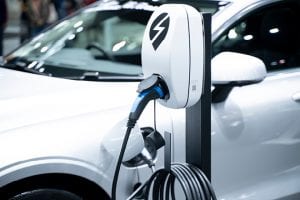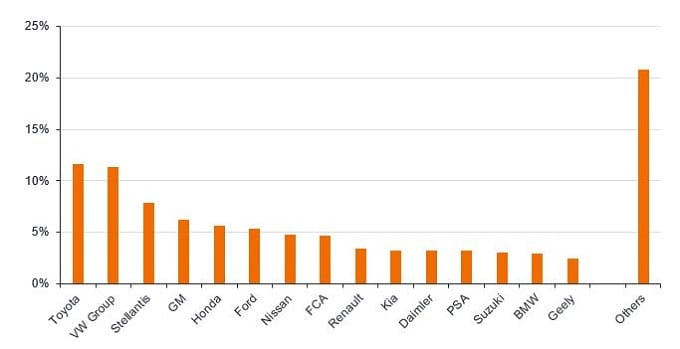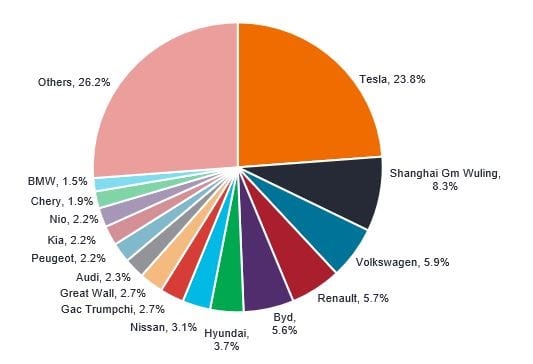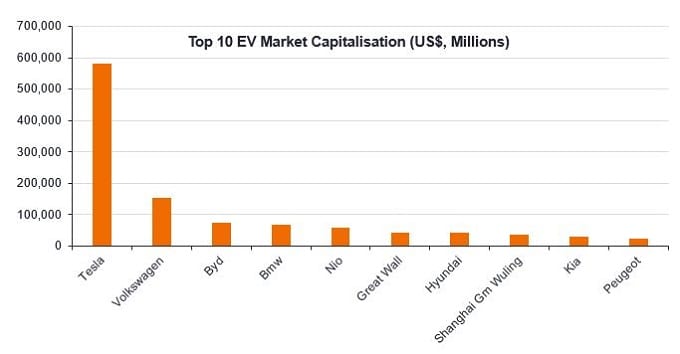Subscribe
Sign up for timely perspectives delivered to your inbox.
There are parallels to be drawn between the growth and evolution of electric vehicles and smartphones, with attractive opportunities for savvy investors, according to Alison Porter, Graeme Clark and Richard Clode.
The dawn of a new era, incumbents scared to embrace the inflection and a new entrant’s share price skyrocketing with a market capitalisation greater than many of the incumbents combined ̶ no, not Tesla and electric vehicles (EVs) but Palm and smartphones.
Early trading following Palm’s initial public offering in 2000 during the final days of the dot.com bubble propelled its valuation to US$53billion, more than that of Apple and Amazon combined. A decade later when smartphones did finally take off, Palm Pilots were a distant memory and an unheard of Canadian company; Blackberry now dominated the smartphone market. However, within a couple of years a little-known company from Taiwan called HTC had usurped them to become the dominant smartphone maker in the US in 2011, overtaking Apple and Samsung for good measure. Fast forward to another decade and Apple, Samsung and the Chinese dominate the smartphone market and Palm, Blackberry and HTC are but footnotes in history.
Palm, Blackberry and HTC did not have feature phone businesses, so lacked the incumbency that made others reluctant to embrace the smartphone trend. Designing with a blank piece of paper they created products that were far superior to anything created by the legacy feature phone makers, often optimised for specific uses like work emails. They also exploited the challenges of a nascent, fast-evolving technology to marry the latest hardware and software capabilities. It used to be a race to get the latest software release to actually work on the latest microprocessor from the likes of Qualcomm.
However, the advent of reference designs, where Qualcomm or Mediatek optimised and did the heavy lifting of getting their processors to work with Google’s Android, massively reduced the barriers to entry and unleased a much faster evolutionary curve. HTC’s franchise advantage disappeared while Blackberry and Nokia as vertically integrated players struggled to keep pace on innovation. Only Apple was able to stay ahead of the curve independently. The smartphone world became dominated by two operating systems, Apple’s iOS and Google’s Android. In the latter camp only the scale and vertically- integrated components of Samsung allowed them to prosper, with the rest of the market squeezed out by the low-cost Chinese players. The recently announced exit of LG is only the latest acknowledgement of this sad reality.
 The automotive industry is in the midst of a similar revolutionary transition to electric vehicles (EVs). The legacy incumbents have proved incredibly reluctant to embrace this trend, given their internal combustion engine (ICE) business models, enabling new entrants to steal a march on them, notably Tesla. Belatedly they are now reacting but like their feature phone cousins often this has been compromised by trying to repurpose an ICE design and supply chain to EVs rather than starting with a blank sheet of paper.
The automotive industry is in the midst of a similar revolutionary transition to electric vehicles (EVs). The legacy incumbents have proved incredibly reluctant to embrace this trend, given their internal combustion engine (ICE) business models, enabling new entrants to steal a march on them, notably Tesla. Belatedly they are now reacting but like their feature phone cousins often this has been compromised by trying to repurpose an ICE design and supply chain to EVs rather than starting with a blank sheet of paper.
Like the early days of the smartphone, the nascent electric vehicle industry had many technological challenges to overcome and no big incumbent players looking to solve them. Tesla initially struggled to secure battery suppliers and resorted to using off-the-shelf laptop batteries. Batteries, electrical drive trains and charging systems were all new areas compared to traditional ICE supply chains. Tesla, as a vertically integrated new entrant, leveraged that advantage to design with a blank sheet of paper what they thought to be the best EV in the market. With no compromises to legacy ICEs, brand-new architecture, the best batteries produced in their own gigafactories, upgradable software, new autopilot capabilities, their own charging infrastructure and sold directly to consumers, Tesla was the very definition of a disruptive new entrant.
However, as the EV industry grows and matures how many of these initial advantages will be sustainable and what are the long-term implications for the industry? Merchant battery cell makers like LG Chem, CATL and Samsung SDI are rapidly closing the gap with Tesla, while VW and Ford have announced ambitious plans to vertically integrate batteries. Naturally, as battery densities improve and EV range extends, consumer ‘range anxiety’ will fade. This will also negate the need for a proprietary charging network that will also become increasingly standardised. Incumbent automakers have finally recognised the need for better EV design, resulting in high quality new EV models emerging from the likes of Audi, Porsche, BMW and Hyundai. Bringing to bear their existing manufacturing scale and expertise, costs are also coming down rapidly. Consequently, Tesla has been losing market share in the US and Europe.
In today’s ICE market no automaker has more than 15% market share and it remains a highly fragmented market (Figure 1). Tesla today is in the lead with 22.6% share in the nascent EV market (Figure 2). But with a plethora of EV models being launched by incumbent automakers, as well as a host of new EV brands in China like Nio and Xpeng and start ups globally like Rivan and Frisker, the sustainability of the situation is debatable. Meanwhile, the rumoured entry of Apple into the market only clouds the picture further.


In the early days of the smartphone it would have been a very prescient investor who could predict the rise and fall of Palm, Blackberry and HTC, and realise that ultimately it would be a PC maker (Apple) and a search engine (Google) that would be the dominant platforms. And that it would be Samsung, not Nokia, that would survive from the feature phone world, while the likes of Xioami, Vivo an Oppo had not yet been founded. Similar challenges present themselves when assessing the EV inflection and there are parallel dangers in extrapolating early trends.
Perhaps the most important analogy from the smartphone era is to focus less on the hardware. In the same way smartphones have become fairly commoditised, it is likely that so too will EVs. The car will become yet another client for the delivery of internet services. As such, controlling the operating system and therefore gateway to these EV clients will be key, in the same way it was for Microsoft in the PC and Apple and Google in the smartphone eras. Will that be open source like Android or a walled garden like Apple has created? If the latter, will Tesla or a new entrant become dominant? Will the automotive incumbents successfully pivot their companies to be software centric?
As with smartphones, betting on the winning EV brand is difficult and there will be an awful lot of competition along the way. But there are opportunities to invest in key EV suppliers that are agnostic to which EV brands do well and have limited suppliers, high barriers to entry and attractive margins.

Suppliers who can provide electrification reference designs will reduce time to market and enable new entrants in the same way as their smartphone forefathers. Power semiconductors are essential for the power management and charging of EVs and are transitioning to more advanced, efficient and greener technologies like silicon carbide (SiC). More advanced intelligent battery management systems are driving greater battery efficiency. As a result we are seeing improvements in range, wireless charging as well as the lifespan of batteries via a second life in energy storage. The accompanying transition to Advanced Driver Assistance Systems (ADAS) and autonomous driving requires a step change in sensor capability across a range of technologies such as radar, lidar and computer vision, ultimately requiring more central processing power and a new ethernet networking architecture.
The road to a more sustainable future presents attractive investment opportunities for those who know where to look and learn from history.